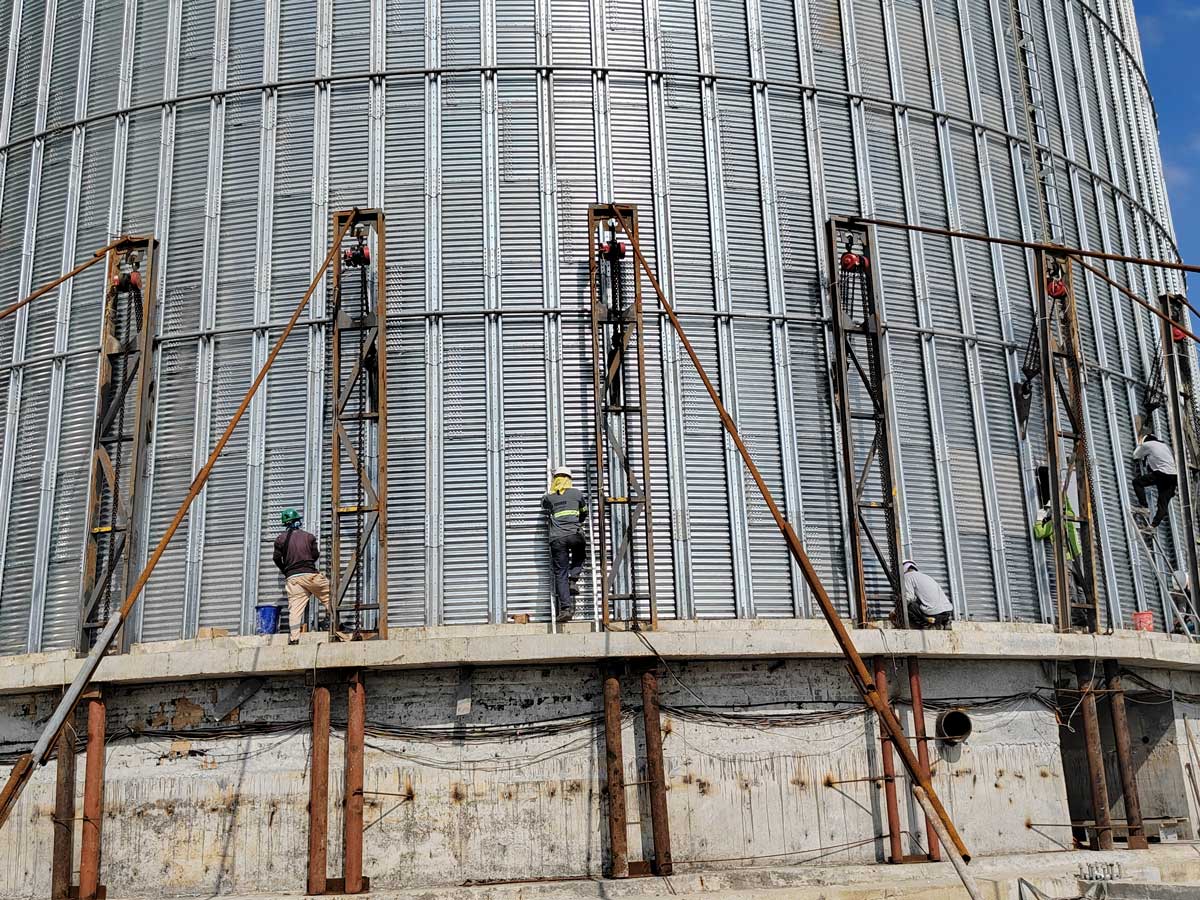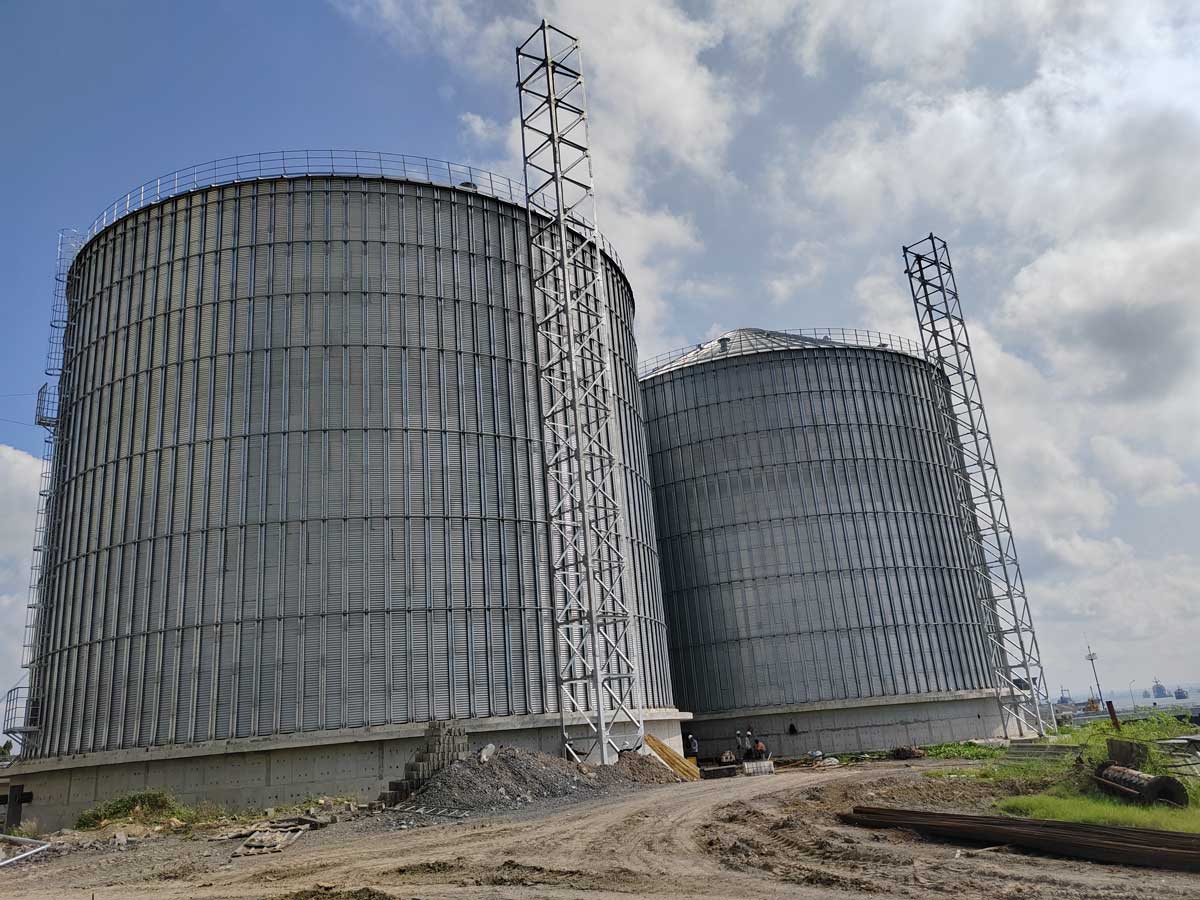Grain storage is crucial for ensuring food supply security, and vertical silos, as efficient grain storage facilities, are widely used for bulk grain storage and management. With global climate change and the increasing severity of pests, pest control and grain quality maintenance have become two core challenges facing vertical silo storage. As an innovative pest control technology, the recirculation fumigation system effectively prevents pest infestations and limits grain quality loss. Through optimal fumigation gas distribution and precise gas concentration control, recirculation fumigation technology can significantly improve grain storage safety.
Features of vertical silo storage system
Silo Structure and Design
A silo consists of three parts: a base, a cylinder, and a roof. The base is typically constructed of concrete, ensuring good load-bearing capacity and moisture resistance, effectively ensuring silo stability. The cylinder, primarily constructed of steel plates or reinforced concrete, offers strong compressive strength, protecting the grain from adverse environmental impacts. Ventilation holes and rain shields are designed into the roof to ensure air circulation. Silo design prioritizes space utilization, optimizing the silo's shape and dimensions to increase storage capacity per unit area.
To improve operational efficiency, silos generally utilize mechanized equipment, equipped with conveying devices and loading and unloading machinery. They also incorporate temperature and humidity control systems to precisely control the temperature and humidity within the silo, ensuring a suitable storage environment for the grain. Importantly, to ensure the effectiveness of the recirculating fumigation system, the silo must be designed to be airtight, using sealing materials and devices to ensure even distribution of the fumigant gas within the silo, achieving an effective concentration.
Silo Storage Environment Requirements
Controlling the temperature and humidity of the grain storage environment is crucial. Generally, the storage temperature should be maintained at around 20°C to reduce grain respiration and extend its shelf life. During hot weather, silos require effective cooling measures, such as ventilation and air conditioning. To ensure the effectiveness of the recirculating fumigation system, the silo structure should be airtight to prevent leakage of fumigant gases.
In addition, to prevent pest breeding, silos must be disinfected during storage to kill insect eggs, mold, and other harmful organisms. Disinfection can be performed using chemical agents or physical methods (such as ultraviolet radiation). Grain should be stored away from direct sunlight, and silo roofs should be equipped with sunshades to prevent accelerated oxidation and quality degradation of the grain.

Application of Circulation Fumigation System in Vertical Silos
Application Design
The key to designing a recirculation fumigation system is ensuring that fumigant gases, such as phosphine, are evenly distributed throughout the grain pile. To achieve this, the layout of the recirculation piping is crucial. Piping should be constructed of corrosion-resistant materials to ensure long-term durability. Typically, the piping is arranged along the silo wall, forming a ring or mesh structure. This allows the gas to circulate within the silo, avoiding dead corners.
The connections between the piping and the fan, dosing system, and other equipment must be tightly sealed to prevent gas leakage. Flange connections, welding, and other methods can be used to ensure a good seal at the piping joints. Regarding the dosing method, the appropriate method (e.g., bottom or top dosing) should be selected based on factors such as the silo's capacity, airtightness, and temperature, and the dosage of the chemical should be accurately calculated.
Fumigation Process Control
During the fumigation process, the circulating fumigation system requires precise control of the phosphine gas concentration. Typically, the effective insecticide concentration of phosphine is between 0.1mg/L and 0.3mg/L. Real-time concentration monitoring allows for adjustment of the dosage based on concentration fluctuations, ensuring optimal insecticide efficacy.
During the fumigation process, the phosphine concentration is recorded every hour. When the concentration falls below the target, the dosage is increased; when the concentration exceeds the target, the dosage is reduced. The fumigation process typically lasts 48 to 72 hours to ensure complete pest control. During the aeration phase, the phosphine concentration must be reduced to below 0.01mg/L, and the aeration period must be at least 24 hours.
Safety Measures
The operation of a recirculating fumigation system requires strict safety measures. First, operators must wear personal protective equipment that meets national standards and undergo regular inspections to ensure it is in good condition. Operators also need to receive professional training to understand the properties and hazards of fumigants and master operating procedures.
Before fumigation operations, the fumigation equipment must be thoroughly inspected to ensure proper operation. Consumable parts and equipment, such as gaskets and filters, should be replaced promptly to prevent equipment failure and accidents.
The concentration of fumigant gases must be monitored in real time to ensure it remains within a safe range. If concentrations exceed the standard, appropriate emergency measures must be implemented immediately to prevent poisoning incidents.
The application of a recirculation fumigation system in silo storage systems significantly improves grain storage safety and pest control by optimizing system layout, meticulously controlling the fumigation process, and implementing strict safety measures. Recirculation fumigation technology not only effectively kills pests and protects grain quality, but also reduces storage costs and improves grain storage management efficiency. With the continued development and promotion of this technology, recirculation fumigation systems will play a vital role in more silo storage systems, contributing to global food security.

.jpg)

